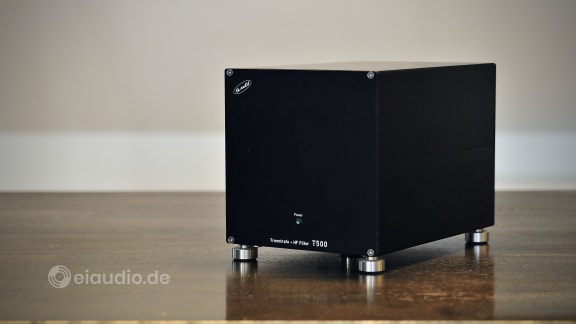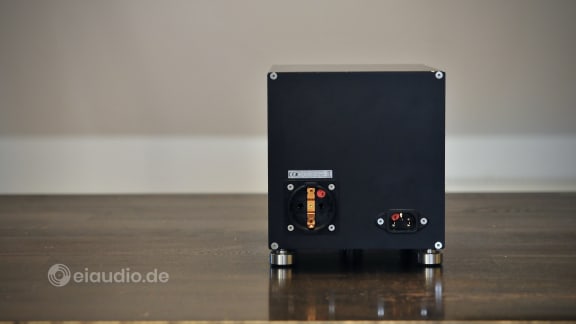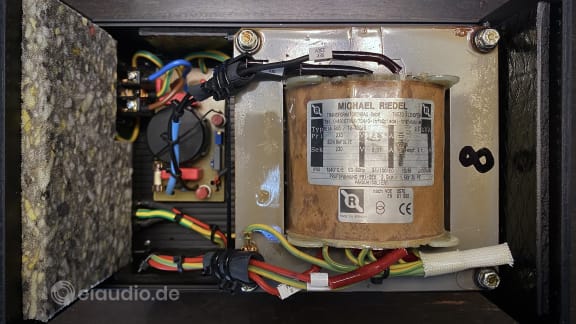TK Audio T500
21/12/2021
Author: Karsten Hein
Category: Gear & Review
Tag(s): Accessories
It has often been described, for instance in my article on system grounding here in this blog, that differences in ground potential between Hi-Fi components will be disruptive to the integrity of the music signals processed and exchanged within a system. In audiophile setups, therefore, lots of effort and money is invested into the approximation of ground potentials. In this context, it is important to understand that ground potentials exist on all Hi-Fi components, even if no additional 'earth' wire has been included in the power cord, because, in AC voltage, the hot phase fluctuates against a neutral (= ground) conductor. This is as true for the operating voltage as it is for the signal ground. On the inside of each Hi-Fi unit, it is common to use a type of star-grounding to harmonise potentials, either through circuit board design (e.g.: Dynaco PAS-4 preamplifier) or through direct wiring (e.g.: B&K ST140 amplifier). However, star grounding works just as well between Hi-Fi units (e.g.: Audioplan PowerStar distributor).
While differences in ground potential can be measured, most audiophile listeners prefer to harmonise ground potentials by starting from a common ground and aligning the power plugs of each additional unit by means of A/B listening comparisons. To a guitarist, the correct tension of each string is determined by listening to it. In a similar way, the tonality and homogeneity of a Hi-Fi system change, if it is struggling with less-than-ideal grounding between the devices. Audiophiles place their emphasis on listening to unconstrained sound, simply because it matters to their ears. If a system is of poor tonal balance, lacking transients, dynamics, etc. it cannot address the listener's emotions in the same way, is not engaging to listen to, and will soon be replaced by other past-time activities. Audiophile accessories — however superfluous they may seem to an outsider — mainly serve one common purpose: to achieve sonic integrity.
Having followed the path of audiophile listening for a number of years now, we had — through multiple improvements — set up our systems to the best of our ability and achieved a balance of tonal richness and musical detail that was rarely found on Hi-Fi systems. This was the result of well-engineered products having been meticulously set up to allow for free-flowing music signals on the basis of harmonised ground potentials. Only the best materials and cable designs had been used to achieve a highly pleasing result. Hence, when my friend and fellow audiophile Luigi dropped off his TK Audio T500 isolating transformer, I could not imagine one aspect of our system that could still benefit from this. The sound of our setup was already at a level of sophistication that I had previously never imagined possible. However, since my project is called 'Explorations in Audio', I had no other chance but to find out for myself.
Before starting to run listening tests and write this review, I carried the black 12 kg box up the stairs to our studio in order to take the photos. The T500 seemed to have been carved from a single block of metal. It did not make the slightest sound when I picked it up, dragged it upstairs, or set it down on our wooden table. This somehow caught me by surprise and instantly made me want to look under the hood. What I found inside were a large isolating transformer, some very solid wires with high-quality terminations, and a small circuit board holding the HF filter unit. The inside of the cabinet was fitted with two types of non-resonant absorbers, and both the transformer and the board were held down by sturdy metal bolts. It became clear to me that the manufacturer, TK Audio, had spent lots of time on the design and execution of this unit to come up with the best conceivable solution for their product, despite production numbers for specialised audio applications of this kind being relatively small. A lot of these High End audio products actually start out from crafty audiophiles building solutions for themselves.
I decided to run my listening tests of the T500 on our Martin Logan system in the main listening room, as our electrostatic speakers were capable of exposing even the smallest alterations in music signals. And, since turntables were symmetrical and basically passive devices, I felt that they should be most resilient to changes in the mains voltage. As far as I knew, the power supply on a turntable primarily served to drive the motor, strobe-light, and the motor electronics, whereas the music signal was generated through magnetic induction into coiled wire and then transferred from the cartridge to the preamplifier through the tonearm cable. I could not see how an isolating transformer would be a benefit in this scenario, unless there was ground potential from the motor and electronics to the platter, in which case, the needle might serve as grounding-bridge to the tonearm. Turntable designers will probably feel the need to chuckle at my musings. Therefore, if you have a deeper understanding about ground potential on turntables, do feel free to leave a comment below.
I first listened to the system with our Sansui SR-525 turntable as source, performing Malia’s album “The Garden of Eve”. For practical reasons, I focused on the album's first two songs “Hope” and “Last Show”. This particular LP had only recently unveiled its magic to me, following the Audioplan PowerCord S upgrade on the external power supply of our Restek V1 preamp. The Sansui, just like all other components of our system, was plugged into an Audioplan PowerStar distributor of an early generation. Once I had familiarised myself afresh with the lazy-cruising sound of the album, I plugged the TK Audio T500 into the socket where the turntable had been and connected the turntable plug to the 230V power output on the T500. To my surprise, I noticed a slight increase in intensity, with each instrument note receiving an exact termination, comparable to being able to see along the side of a raindrop to where it ended. I had not experienced such plasticity from our turntable before, and, switching back and forth between the modes of connection, I noticed an increase in dynamics that made the music seem slightly louder and more piercing. There was this new urgency and clarity to the music. Channel separation also seemed to have improved.
Turning the T500’s plug in the socket, shifted the tonal balance upward and negatively affected the natural timbre of Malia’s voice. I found this change to be quite unpleasant to the ears and took a mental note that polarity mattered on isolating transformers (with HF filter modules). I was curious to find out, if grounding also played a role in conjunction with such transformers and plugged the T500’s power cord into an adjacent wall-outlet. While the performance was still pretty solid, some of the tonal balance was lost, similar to the effect of inverting the plug. The sound became overly muffled when changing polarity in the remote socket. From this, I concluded that isolating transformers, too, should be included in the star grounding of the system, and that one should listen to the plug turned in either direction. I have not yet tested our CD player on the T500, but I will keep adding to this article, if doing so should lead to additional findings or a completely different result.
About TK Audio
TK are the name initials of a German engineer who set out to build a small line of high-quality power filters and audio cables for the local audiophile community. A dedicated audio shop based in Frankfurt compared these to other available products on the market and decided to place a substantial order with him in order to distribute them among their own customers. Sadly, the engineer himself stopped production shortly after and withdrew from the market, when he found his filters and cables the subject of a 'religious' war, being repeatedly bashed and attacked by the "cables-don't-matter" and "this-is-all-snake-oil" community in public forums. The excellent products that have remained in circulation are much sought after within the community to this day. The TK brand is not to be confused with the audio module producer TK Audio from Sweden.
Specifications:
- Type: isolating transformer
- Dimensions: (W) 16.5 cm x (D) 24.0 cm x (H) 18.5 cm
- Transformer: Michael Riedel, Germany
- Operating voltage: 230 V to 230 V
- Power handling: 500 W / 2.17 A
- Weight: 12.2 kg
- Place of manufacture: Germany
- Year: 2013






